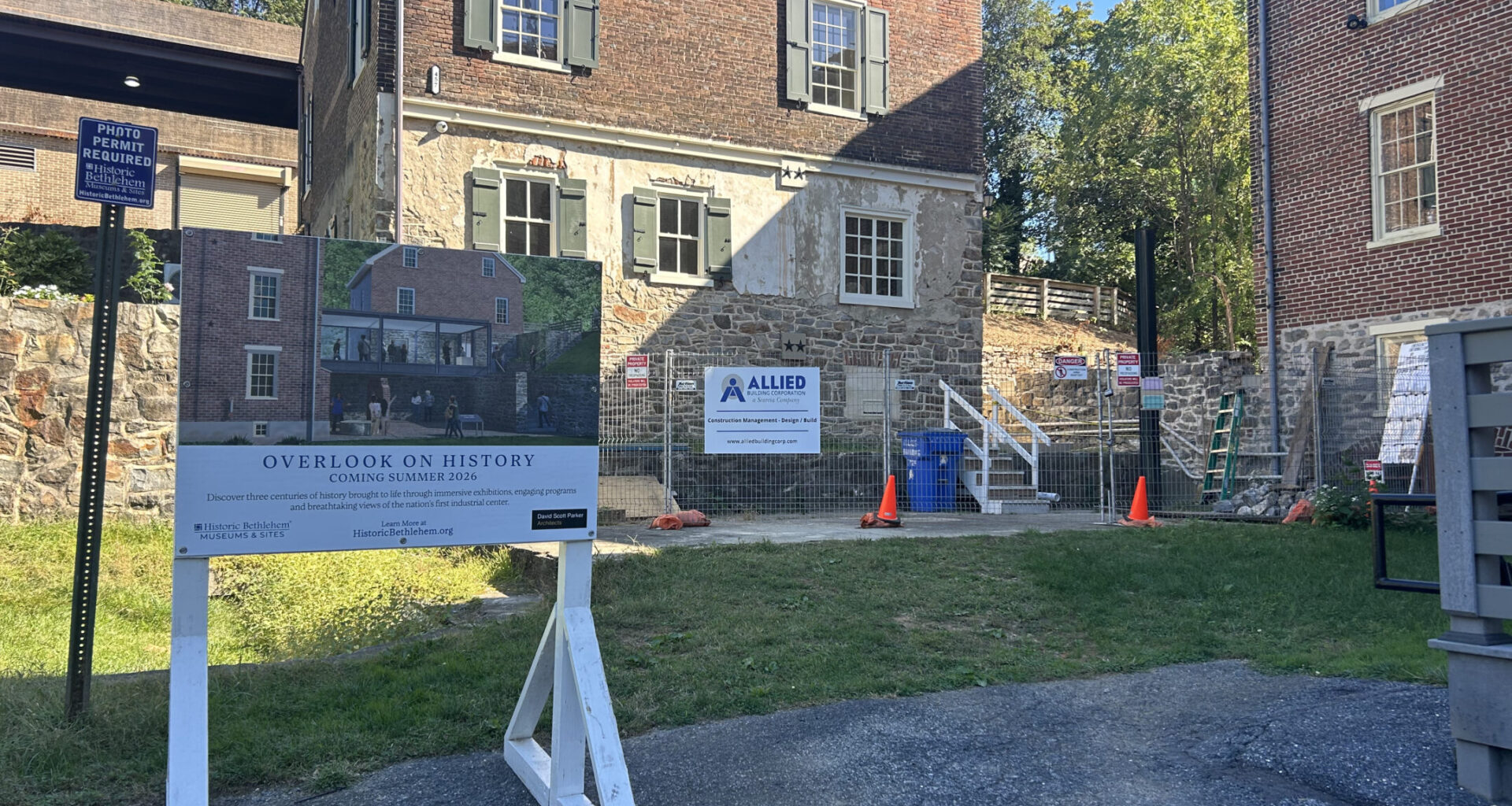Bethlehem’s historic preservation efforts are moving forward with the construction of a new scenic overlook that will connect the 18th-century Grist Miller’s House at 459 Old York Road to the neighboring Luckenbach Mill on the North Side, according to Historic Bethlehem Museums & Sites.
Historic Bethlehem Museums & Sites is leading the project to preserve the city’s Colonial Industrial Quarter, home to a collection of 18th and 19th century buildings along the Monocacy Creek. The $1.5 million project, called the “Overlook on History,” will serve as an educational and exhibition space scheduled to open in late 2026, according to the press release.
For the past 20 years, Historic Bethlehem has worked to save the Grist Miller’s House, which was at risk of collapsing because of its hillside location. The structure was stabilized with steel supports to hold the foundation in place.
David Scott Parker, the project’s lead architect, said once the Grist Miller’s House was stabilized, the next question was what to build inside of it, leading to the idea to connect the house to the neighboring Luckenbach Mill.
According to the organization’s website, the mill has long played a role in Historic Bethlehem’s operations, originally established by the Moravians who milled grain such as wheat and corn on site. The surrounding area once included an industrial community with a tannery, oil mill, dye house and black smith shop.
Parker said linking the two sites created not just a physical bridge, but a new purpose for the Grist Miller’s House.
“When you start thinking about that link, what it means physically, technologically and historically, it becomes a much bigger challenge,” Parker said.
The new Overlook Gallery will be between two buildings and is suspended above 18th-century archaeological remains. Parker said engineers had to ensure the structure wouldn’t disturb the archaeological site, which has yet to be explored.
Construction crews must also account for the Colonial Industrial Quarter’s location within a FEMA-designated floodplain. Parker said this means no habitable or mechanical space can be placed below the base flood elevation.
He also said building within a historic setting comes with its own challenges and standards.
In the U.S., projects involving historic structures are guided by the Secretary of the Interior’s Standards for the Treatment of Historic Properties, established after the National Historic Preservation Act of 1966 that codified the protection of historic resources.
According to the National Park Service, the standards include preservation, rehabilitation, restoration and reconstruction.
Across the four standards, Parker said one principle remains constant: new construction should be distinguishable from the old and reflect the era in which it was built. Rather than replicating 18th-century architecture, he said the new design embraces a contemporary look that complements, rather than imitates, its surroundings.
“These standards are really the gold standard for evaluating how new additions or restorations relate to historic buildings,” Parker said.
Ralph Schwarz, who helped shape Bethlehem’s early preservation initiatives, also contributed to developing the framework that became the Secretary of the Interior’s Standards.
Parker said Bethlehem’s connection to the preservation movement itself makes this project especially symbolic.
“This structure doesn’t just exist in Bethlehem,” Parker said. “It also exists symbolically in the history of the preservation movement.”
This year, the Bethlehem Historic District Association donated $20,000 to support the Grist Miller’s House project.
A representative of the association, Michele Shultz, said this brought the organization’s total contributions to Historic Bethlehem Museums & Sites to more than $50,000, which is part of the association’s ongoing efforts to preserve Bethlehem’s historic landmarks.
Schultz said the association’s mission is to build a sense a community within the neighborhood.
“Every time one of the interiors or exteriors of these structures is preserved or restored, there’s a real sense of gratitude and excitement in the community,” Schultz said. “For neighbors who’ve lived here for decades, I think there’s a deep sense of relief and pride every time one of these big projects is completed.”
In 1961, Pennsylvania passed the Historic District Act, allowing municipalities to create their own historic districts. Schultz said this designation is both a source of local pride and official recognition by the state.
Bob Lund, who grew up on the west side of Bethlehem in the 1960s, said he supports the city’s preservation efforts.
“When I was a kid, we used to explore the ruins of the old industrial part of Bethlehem, and to see it now restored and thriving is really something special,” Lund said.
Today, the Luckenbach Mill serves as a rotating exhibit gallery featuring art, history and technology displays. The Grist Miller’s House will feature exhibits focused on interpreting the Moravian Industrial Quarter.
Mark Steigleman, the director of collections and programming for Historic Bethlehem, said he plans to curate an exhibition in the new space.
Steigleman said when it opens, one of the first exhibits will feature black-and-white photographs of the Colonial Industrial Quarter buildings taken in the 1960s and ‘70s, before the buildings were rehabilitated. The images show the structures in various states of disrepair.
The addition is expected to open in spring 2026. The Lukenbach Mill will still be open to the public as construction follows.

